Michael J. Behe's Blog, page 484
May 9, 2019
If no one is really a Darwinist any more…
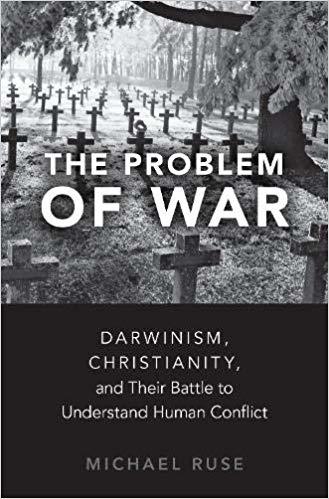
How to explain this? In his recent book The Problem of War: Darwinism, Christianity, and their Battle to Understand Human Conflict (2018), Darwinian philosopher Michael Ruse says, “Today’s professional evolutionists are committed Darwinians. They think that natural selection is the chief cause of change . . .” (p. ix)
Maybe, despite the most stellar achievements, any biologists who doubt are not “professional” evolutionists?
Follow UD News at Twitter!
See also: Astronomer Martin Rees reacts to Suzan Mazur’s Darwin Overthrown The story addresses the way Rees has been in the background of creative thinkers in biology who are grappling with what we now know. Non-Darwinian things.
Copyright © 2019 Uncommon Descent . This Feed is for personal non-commercial use only. If you are not reading this material in your news aggregator, the site you are looking at is guilty of copyright infringement UNLESS EXPLICIT PERMISSION OTHERWISE HAS BEEN GIVEN. Please contact legal@uncommondescent.com so we can take legal action immediately.
Plugin by Taragana
Altruism? In viruses?
 vesicular stomatitis virus
vesicular stomatitis virusSome insist that viruses are not alive. But then, what about this?
In a recent study published in Nature Microbiology, Rafael Sanjuán, an evolutionary geneticist at the University of Valencia in Spain, and his colleagues used a combination of theory and experiments to explore viral cooperation and conflict. They found that the spatial structure of a viral infection — the way that different sets of viruses can be isolated in separate compartments of the infected body — matters tremendously. In an evenly mixed system, altruistic viruses fall victim to “cheaters” that take advantage of their sacrifices, but if pockets in the body can isolate and shelter the altruists, they have a shot at survival.Viviane Callier, “Viruses Have a Secret, Altruistic Social Life” at Quanta
A long discussion ensues, re Darwinian competition between altruists and cheaters.
But for now, how can viruses have altruism if they are not alive? Let’s assume that this is not an argument for panpsychism (You are conscious, sure, but so is your coffee mug.) It seems to be an argument that viruses behave as life forms do. But somehow the issue never gets settled.
Before you go: One way viruses get spread “never should have evolved”
Reset! Different segs of virus genome can exist in different cells but work together
Viruses devolve. (PaV)
Virus expert highlights the conflict over whether viruses are alive In short, it is an open question. The question relates to the role viruses can play in evolution, among other things. Are they precursors of life, detritus of life, or something in between? Or all three? Keep the file open.
Viruses invent their own genes? Then what is left of Darwinism?
Why viruses are not considered to be alive
Another stab at whether viruses are alive
Phil Sci journal: Special section on understanding viruses
Should NASA look for viruses in space? Actually, it’s not clear that RNA came first. Nor is it clear that viruses precede life. A good case can doubtless be made for viruses being part of the scrap heap of existing life. But no matter. If you think you can find viruses in space, boldly go.
Why “evolution” is changing? Consider viruses
The Scientist asks, Should giant viruses be the fourth domain of life? Eukaryotes, prokaryotes, archaea… and viruses?
and
Are viruses nature’s perfect machine? Or alive?
Follow UD News at Twitter!
Copyright © 2019 Uncommon Descent . This Feed is for personal non-commercial use only. If you are not reading this material in your news aggregator, the site you are looking at is guilty of copyright infringement UNLESS EXPLICIT PERMISSION OTHERWISE HAS BEEN GIVEN. Please contact legal@uncommondescent.com so we can take legal action immediately.
Plugin by Taragana
Researchers: Sediba is not a human ancestor after all. Back to Lucy, but…
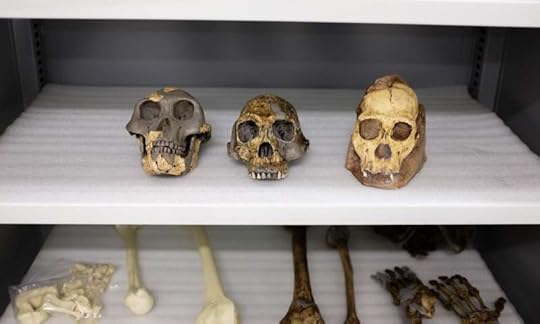
Fossil casts of Australopithecus afarensis (left), Homo habilis (center), and Australopithecus sediba (right) Credit: Matt Wood, UChicago
Rumors flew that Sediba would be dumped in 2017. But Lucy isn’t a straightforward candidate either, it turns out. Now, from ScienceDaily:
Statistical analysis of fossil data shows that it is unlikely that Australopithecus sediba, a nearly two-million-year-old, apelike fossil from South Africa, is the direct ancestor of Homo, the genus to which modern-day humans belong.
The research by paleontologists from the University of Chicago, published this week in Science Advances, concludes by suggesting that Australopithecus afarensis, of the famous “Lucy” skeleton, is still the most likely ancestor to the genus Homo.
The first A. sediba fossils were unearthed near Johannesburg in 2008. Hundreds of fragments of the species have since been discovered, all dating to roughly two million years ago. The oldest known Homo fossil, the jawbone of an as yet unnamed species found in Ethiopia, is 2.8 million years old, predating A. sediba by 800,000 years.
Despite this timeline, the researchers who discovered A. sediba have claimed that it is an ancestral species to Homo. While it is possible that A. sediba (the hypothesized ancestor) could have postdated earliest Homo (the hypothesized descendant) by 800,000 years, the new analysis indicates that the probability of finding this chronological pattern is highly unlikely. Paper. (open access) – Andrew Du and Zeresenay Alemseged. Temporal evidence shows Australopithecus sediba is unlikely to be the ancestor of Homo. Science Advances, 2019 DOI: 10.1126/sciadv.aav9038 More.
The discussion of probabilities is interesting:
“It is definitely possible for an ancestor’s fossil to postdate a descendant’s by a large amount of time,” said the study’s lead author Andrew Du, Ph.D., who will join the faculty at Colorado State University after concluding his postdoctoral research in the lab of Zeray Alemseged, Ph.D., the Donald M. Pritzker Professor of Organismal and Biology and Anatomy at UChicago.
“We thought we would take it one step further to ask how likely it is to happen, and our models show that the probability is next to zero,” Du said.
Du and Alemseged also reviewed the scientific literature for other hypothesized ancestor-descendant relationships between two hominin species. Of the 28 instances they found, only one first-discovered fossil of a descendant was older than its proposed ancestor, a pair of Homo species separated by 100,000 years, far less than the 800,000 years separating A. sediba and earliest Homo. For context, the average lifespan of any hominin species is about one million years.
“Again, we see that it’s possible for an ancestor’s fossil to postdate its descendant’s,” Du said. “But 800,000 years is quite a long time.” University of Chicago Medical Center, “Statistical study finds it unlikely South African fossil species is ancestral to humans” at Phys.org
So we’re back with Lucy again, for now at least. But the evidence for Lucy is hardly decisive either:
“This is probability statistics at its best,” said Yohannes Haile-Selassie, a physical anthropologist from the Cleveland Museum of Natural History, in an email to Gizmodo. “I had no doubt in my mind—nor did many in our field—that A. sediba could not have been the ancestor of Homo, not only because the earliest known representative of Homo is 800,000 years older, but also because A. sediba does not have all of the morphological features that one would expect to see from the earliest Homo,” said Haile-Selassie, who wasn’t involved with the new research.
“I hope Du and Alemseged’s work lays this issue to rest,” he wrote. “We still have to look for the ancestor of the genus Homo even though A. afarensis appears to be the best candidate for now. Let’s keep looking, the fossil record is always full of surprises!” George Dvorsky, “New Analysis Debunks Controversial Claim About the Origin of Humanity” at Gizmodo
The anthropologist is right, the fossil record is full of surprises. But the news that Lucy is only “the best candidate” is worth some reflection. It sounds like we have little to go on and Lucy is at best plausible.
Hat tip: Philip Cunningham
See also: Australopithecus sediba to be dumped from human family? (2017)
and
Choosing between Sediba and Naledi as human ancestor? (2015)
Follow UD News at Twitter!
Copyright © 2019 Uncommon Descent . This Feed is for personal non-commercial use only. If you are not reading this material in your news aggregator, the site you are looking at is guilty of copyright infringement UNLESS EXPLICIT PERMISSION OTHERWISE HAS BEEN GIVEN. Please contact legal@uncommondescent.com so we can take legal action immediately.
Plugin by Taragana
May 8, 2019
Rob Sheldon: Are multiple measurements “closing in” on dark energy? Nope.
Recently, we were informed that multiple measurements are indeed getting somewhere:
An extensive analysis of four different phenomena within the universe points the way to understanding the nature of dark energy, a collaboration between more than 100 scientists reveals.
Dark energy – the force that propels the acceleration of the expanding universe – is a mysterious thing. Its nature, writes telescope scientist Timothy Abbott from the Cerro Tololo Inter-American Observatory, in Chile, and colleagues, “is unknown, and understanding its properties and origin is one of the principal challenges in modern physics”.
Indeed, there is a lot at stake. Current measurements indicate that dark energy can be smoothly incorporated into the theory of general relativity as a cosmological constant; but, the researchers note, those measurements are far from precise and incorporate a wide range of potential variations.Andrew Masterson, “Multiple measurements close in on dark energy” at Cosmos Magazine
So what difference will combining multiple measurements make? We asked our physics color commentator Rob Sheldon, of course:
Well, “closing in” is one of those meaningless phrases, because it means “shrinking the error bars in the model”, which says nothing about the model being correct. All it does is reveal whether or not the model was as good as it was touted in yesterday’s breathless press release. (It isn’t.) Which is to say, if the results had been at all positive, the presser would have likely said “Confirmation!!!!” or something like that. Seeing as the new results are neutral or faintly negative, “closing in” is the best they can manage.
But I don’t want to put words in their mouths, let me quote the offending passages:
“Dark energy – the force that propels the acceleration of the expanding universe – is a mysterious thing. Its nature, writes telescope scientist Timothy Abbott from the Cerro Tololo Inter-American Observatory, in Chile, and colleagues, “is unknown, and understanding its properties and origin is one of the principal challenges in modern physics”.”
So we don’t know what it is, how it works, its properties or where it comes from. But we’re “closing in” on it all the same. How?
By measuring its effects on other stuff. Namely, looking at 2 things:
“First, it deforms galactic architectures through accelerating the expansion of the universe. Second, it suppresses growth in some parts of the cosmic structure.”
Now I want to draw your attention to the verbs– “deforms” and “suppresses”. Both of these are changes–the first is a change in shape, and the second is a change in a change. So to measure a change in these things you have to have a measurement before the current one.
Now comes the kicker. Astronomy has been measuring these things for, oh, maybe 50 years, maybe 100 if we can get hold of some old glass plates from the turn-of-the-century. But the universe changes visibly on the scale of a 100-million-years to billion-years, so we’re talking changes of 100/10^8 = 0.0001% change in these variables. Is it likely that comparing present photographs with ones taken in 1919 can measure a 1:10^6 variation? If a star has a width of 1mm in the old plate, we’re talking 1 micrometer of precision in the new photographs. Is that possible?
The answer is No. Nobody’s talking about using old photographs to measure changes. What we’re talking about is models. The variables in the models can be changed in the 6th decimal place, and then we can compare the output changes to our assumed input. Remember the Planck team had 17 variables in their model that they displayed to the 6th decimal place? That’s what this article is talking about–changes in a model.
But it says nothing about whether it is the right model or not. Here’s how the scientists describe the problem themselves.
“However, it is not the only force that can produce such results, and the danger thus always exists that what is assumed to be evidence of dark matter activity may in fact be something else altogether.”
Exactly. The model may be very precise, but inaccurate because it is the wrong model. This is what all my previous posts have been saying. Precision is not accuracy.
So how are we to proceed?
Well one method is to try to validate the model. This is attempted by using multiple, independent lines of evidence to try and show that this model works on things that it was not designed to fit. The keyword here is independent. In statistics, this independence or randomness leads to a confidence measure called the “p-value” and it absolutely requires “no peeking” at the result beforehand. Bending the rules gives a false sense of confidence and different methods of cheating are variously called “cherry picking”, HARKing, p-hacking, etc.
And what do they find?
The independent measures give non-overlapping answers. In other words, the model is not valid. See, for example, the figure in this article about dark energy:
And here is where the article gets quite fascinating. Because this is where the scientists do exactly the wrong thing. Since they didn’t get a confirmation, they threw all the data into one pot, destroyed its independence by making a single data set out of it, and forced the model to depend on ALL of these lines of evidence.
“The researchers approach this challenge by invoking a combination of multiple observational probes for low-redshift phenomena – namely, those measuring Type Ia supernova light curves, fluctuations in the density of visible (or “baryonic”) matter, weak gravitational lensing, and galaxy clustering….Presenting the first tranche of results from the survey, Abbott and colleagues reveal progress towards constraining the nature of dark energy.”
Why turn independent data into dependent model fits?
Ostensibly to improve the error bars on the model, but more importantly, since they can’t validate the model, at least they can improve the model fits. This despite the fact that they said that they don’t know very much about dark energy at all, and it might not be modeled correctly, yada yada. Nevertheless, at the end of the day, you don’t draw a paycheck for saying that everyone’s livelihood was a waste of time, rather, you are paid to add another digit to the precision measurement of that waste of time.
But wait, am I not being unfair? Didn’t they just say that they measure the naked effects, not the modeled cause?
“Further planned DES surveys, they conclude, will likely sharpen up knowledge of the impact of dark energy in the universe by orders of magnitude.”
Okay, I’m being a tiny bit unfair. The “impacts” they are discussing are indeed observations, but observations passed through a model. When the model is eventually updated (as indeed the Planck team is demonstrating the need for a new one) in principle they will still have the observations which can then be passed through the new model. At least, we sincerely hope they will archive their original observations and not these useless model fits. NASA has been known to throw out old data in the past, so it has happened before.
Until then, we will just have to endure these “closing in” pronouncements of imaginary progress on a model known to be invalid.
PS. Didn’t we just read over at Forbes that Ethan Siegel says there’s no other alternative but dark matter and dark energy?
“This is the problem with every alternative. Every alternative to the expanding Universe, to the Big Bang, to dark matter, dark energy, or inflation, all fail to even account for whatever’s been already observed, much less the rest of it. That’s why practically every working scientist considers these proposed alternatives to be mere sandboxing, rather than a serious challenge to the mainstream consensus.”
Let’s see, where else do we find the argument “no other alternative” and “mainstream consensus”– Darwin, global warming, origin-of-life, dying coral of the Great Barrier Reef, unilateral disarmament, no-zero-threshold toxins, mandatory vaccination, single-payer-healthcare. And if we go back in history, we’ve got miasma (bad air) for disease, phlogiston (heat content of wood), ether (light waves in a vacuum), spontaneous generation (for origin of life), but I think your readers are getting my point. If there ever needs to be a contest for the oxymoron of our age, the winner isn’t “military intelligence” but “scientific consensus.”
And he’s incorrect about “no alternatives” too. If he wants to read my paper on a magnetic alternative, it’s in review at “Proceedings of the Blythe Institute” with preprints on my website.
Follow UD News at Twitter!
![The Long Ascent: Genesis 1â 11 in Science & Myth, Volume 1 by [Sheldon, Robert]](https://i.gr-assets.com/images/S/compressed.photo.goodreads.com/hostedimages/1541285109i/26543752.jpg)
Rob Sheldon is the author of Genesis: The Long Ascent
See also: At Forbes: Cosmology’s crisis is merely “manufactured misunderstandings”
An astrophysicist dismisses the concerns as “ideologically-driven diatribes.”
and
Rob Sheldon: The real reason there is a crisis in cosmology Nearly everything that has failed about the Big Bang model has been added because of bad metaphysics, a refusal to accept the consequences of a beginning. The remaining pieces of the Big Bang model that are failing and which can’t be attributed to bad metaphysics, were added from sheer laziness.
More on dark energy: Researchers: Either dark energy or string theory is wrong. Or both are. But dark energy is so glitzy! Isn’t it a line of cosmetics already?
Researchers: The symmetrons needed to explain dark energy were not found
Rob Sheldon: Has dark energy finally been found? In pop science mags?
Are recent dark energy findings a blow for multiverse theory?
and
Science at sunset: Dark energy might make a multiverse hospitable to life… if it exists
Copyright © 2019 Uncommon Descent . This Feed is for personal non-commercial use only. If you are not reading this material in your news aggregator, the site you are looking at is guilty of copyright infringement UNLESS EXPLICIT PERMISSION OTHERWISE HAS BEEN GIVEN. Please contact legal@uncommondescent.com so we can take legal action immediately.
Plugin by Taragana
“Jumping genes” threaten the world’s antibiotics
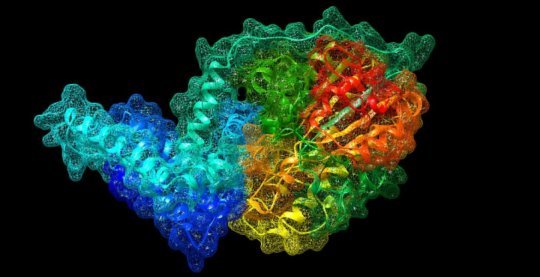
mcr-9 gene’s protein structure/
Ahmed Gaballa, Cornell University
From ScienceDaily:
While sifting through the bacterial genome of salmonella, Cornell University food scientists discovered mcr-9, a new stealthy, jumping gene so diabolical and robust that it resists one of the world’s few last-resort antibiotics.
Doctors deploy the antibiotic colistin when all other infection-fighting options are exhausted. But resistance to colistin has emerged around the globe, threatening its efficacy…
Mcr-9 is the latest in this new series of “mobilized colistin-resistance” genes — originally discovered in 2015. The National Center for Biotechnology Information, part of the National Institutes of Health, has added details about this new gene to its database. Medical professionals and others can now use this information to identify mcr-9 in bacteria isolated from food products and people…
“If you go to a hospital and this gene is floating around, that can be trouble. The gene is moveable. It jumps,” Wiedmann said. “In a hospital setting, being able to screen a patient for resistance allows doctors and nurses to isolate the patient and maintain biosecurity.”
Paper. (open access) – Laura M. Carroll, Ahmed Gaballa, Claudia Guldimann, Genevieve Sullivan, Lory O. Henderson, Martin Wiedmann. Identification of Novel Mobilized Colistin Resistance Gene mcr-9 in a Multidrug-Resistant, Colistin-Susceptible Salmonella enterica Serotype Typhimurium Isolate. mBio, 2019; 10 (3) DOI: 10.1128/mBio.00853-19 More.
Although they are using the term “jumping genes,” it sounds more like horizontal gene transfer, but we won’t quibble. Maybe the term “jumping gene” (which used to mean moving around within a single genome) will come to mean moving between organisms (horizontal gene transfer) as well.
Popular media are getting the picture about the risk:
We’ll give you the bad news first: mcr-9 is highly mobile, per the study. Bacteria can swap genetic information into their DNA, and the readiness with which mcr-9 is transferable means that this antibiotic resistance could rapidly proliferate, rendering existing treatments all-but-useless.Dan Robitzski, “Sneaky bacteria can swap genes, making them immune to antibiotics” at Futurism
Does anyone remember when antibiotic resistance was proof of Darwinism? Antibiotic resistance was Evolution. And Evolution was not non-Darwinian stuff like horizontal gene transfer/jumping genes. Welcome to post-Darwin science.
Follow UD News at Twitter!
See also: Horizontal gene transfer: Sorry, Darwin, it’s not your evolution any more
Follow UD News at Twitter!
Copyright © 2019 Uncommon Descent . This Feed is for personal non-commercial use only. If you are not reading this material in your news aggregator, the site you are looking at is guilty of copyright infringement UNLESS EXPLICIT PERMISSION OTHERWISE HAS BEEN GIVEN. Please contact legal@uncommondescent.com so we can take legal action immediately.
Plugin by Taragana
At Forbes: Cosmology’s crisis is merely “manufactured misunderstandings”
 3-D impression of dark matter via Hubble
3-D impression of dark matter via HubbleAn astrophysicist dismisses the concerns as “ideologically-driven diatribes”:
Once you accept the Big Bang and a Universe governed by General Relativity, there is an enormous suite of evidence that points to the existence of dark matter and dark energy. This is not a new suite, either, but one that’s been mounting since the 1970s. Dark energy’s main competitor fell away some 15 years ago, leaving only a Universe with dark matter and dark energy as a viable cosmology to explain the full suite of evidence.
Once you accept the Big Bang and a Universe governed by General Relativity, there is an enormous suite of evidence that points to the existence of dark matter and dark energy. This is not a new suite, either, but one that’s been mounting since the 1970s. Dark energy’s main competitor fell away some 15 years ago, leaving only a Universe with dark matter and dark energy as a viable cosmology to explain the full suite of evidence.
You have to account for everything, plus the new observation, plus new phenomena that have not yet been observed.
This is the problem with every alternative. Every alternative to the expanding Universe, to the Big Bang, to dark matter, dark energy, or inflation, all fail to even account for whatever’s been already observed, much less the rest of it. That’s why practically every working scientist considers these proposed alternatives to be mere sandboxing, rather than a serious challenge to the mainstream consensus.Ethan Siegel, “Forbes” at [publication]
But that’s precisely why many sense a crisis. There appears to be no way out via new theories.
See also: Rob Sheldon: The real reason there is a crisis in cosmology Nearly everything that has failed about the Big Bang model has been added because of bad metaphysics, a refusal to accept the consequences of a beginning. The remaining pieces of the Big Bang model that are failing and which can’t be attributed to bad metaphysics, were added from sheer laziness.
Discover: Even the best dark matter theories are crumbling
Researcher: The search for dark matter has become a “quagmire of confirmation bias” So many research areas in science today are hitting hard barriers that it is reasonable to think that we are missing something.
Physicists devise test to find out if dark matter really exists
Largest particle detector draws a blank on dark matter
What if dark matter just doesn’t stick to the rules?
A proposed dark matter solution makes gravity an illusion
and
Proposed dark matter solution: “Gravity is not a fundamental governance of our universe, but a reaction to the makeup of a given environment.”
Researchers: Either dark energy or string theory is wrong. Or both are. But dark energy is so glitzy! Isn’t it a line of cosmetics already?
Researchers: The symmetrons needed to explain dark energy were not found
Rob Sheldon: Has dark energy finally been found? In pop science mags?
Are recent dark energy findings a blow for multiverse theory?
and
Science at sunset: Dark energy might make a multiverse hospitable to life… if it exists
Copyright © 2019 Uncommon Descent . This Feed is for personal non-commercial use only. If you are not reading this material in your news aggregator, the site you are looking at is guilty of copyright infringement UNLESS EXPLICIT PERMISSION OTHERWISE HAS BEEN GIVEN. Please contact legal@uncommondescent.com so we can take legal action immediately.
Plugin by Taragana
Astronomer Martin Rees reacts to Suzan Mazur’s Darwin Overthrown
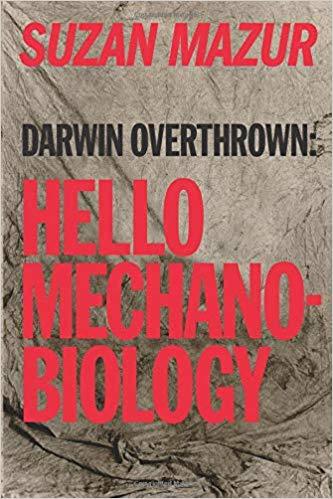
With characteristic boldness, Suzan Mazur showed astronomy icon Martin Rees a copy of her book Darwin Overthrown: Hello Mechanobiology, a move that—with participants other than Mazur and Rees—might have resulted in a trip past the recycle bins on the way out. And not for Rees. So what happened?
“Heresy!” Lord Martin Rees, UK’s Astronomer Royal, exclaimed—though seemingly tongue-in-cheek—when I handed him a copy of Darwin Overthrown: Hello Mechanobiology prior to his May Day Simons Foundation lecture in New York: “Physics in Real and Counterfactual Universes.” Suzan Mazur, “Martin Rees on Darwin Overthrown, Our Flat Universe, and Post-Humans” at Oscillations
 Martin Rees
Martin Rees Hey, “tongue-in-cheek” it had better be if Rees’s own lecture is about physics in real—and counterfactual—universes… 
May 7, 2019
Did the Sino-Tibetan language family originate over 7000 years ago?
From ScienceDaily:
The Sino-Tibetan language family consists of more than 400 languages spoken by around 1.4 billion speakers worldwide, including major world languages like Chinese, Tibetan and Burmese. However, despite the importance of these languages for understanding the prehistory of East Asia, their relationships and origins remain controversial. A study by an international team provides new evidence for the origin of the language family, pointing to Sino-Tibetan originating with north Chinese millet farmers around 7,200 years ago
But how do they know?
In order to shed light on the complex history of these languages, the scholars assembled a lexical database containing core vocabulary from 50 Sino-Tibetan languages. This database, published here for the first time, includes ancient languages spoken 1000 and more years ago, such as Old Chinese, Old Burmese, and Old Tibetan, as well as modern languages documented by field work.
“In order to compare these languages in a transparent way, we developed a specific annotation framework that allows us not only to mark which words we identify as sharing a common origin, but also which sounds in the words we think are related,” says Johann-Mattis List of the Max Planck Institute for the Science of Human History, who led the study. “A particular problem in identifying the truly related words were the numerous cases where languages borrowed words from each other,” mentions Jacques. “Luckily, we know the history of particular languages rather well and could rely on techniques that we developed before to reveal the true history concealed by these borrowings.”
Using powerful computational phylogenetic methods, the team inferred the most probable relationships between these languages and then estimated when these languages might have originated in the past. “We find clear evidence for seven major subgroups with a complex pattern of overlapping signals beyond that level,” says Simon J. Greenhill of the Max Planck Institute for the Science of Human History. “Our estimates suggest that the ancestral language has arisen around 7,200 years ago.” Paper. (open access) – Laurent Sagart, Guillaume Jacques, Yunfan Lai, Robin J. Ryder, Valentin Thouzeau, Simon J. Greenhill and Johann-Mattis List. Dated language phylogenies shed light on the ancestry of Sino-Tibetan. PNAS, 2019 DOI: 10.1073/pnas.1817972116 More.
What we don’t know is how language itself arises. Not at all. Every human group already speaks a language.
See also: At Inference Review: Language is much more than a system of signals
Michael Egnor: The Real Reason Why Only Human Beings Speak
Why speech is unique to humans
Endangered Languages: Efforts To Save Them Sometimes Involve Questionable Claims
and
Rob Sheldon: Did humans see the color blue before modern times?
Follow UD News at Twitter!
Copyright © 2019 Uncommon Descent . This Feed is for personal non-commercial use only. If you are not reading this material in your news aggregator, the site you are looking at is guilty of copyright infringement UNLESS EXPLICIT PERMISSION OTHERWISE HAS BEEN GIVEN. Please contact legal@uncommondescent.com so we can take legal action immediately.
Plugin by Taragana
That day Marcos Eberlin was chased out of Portugal
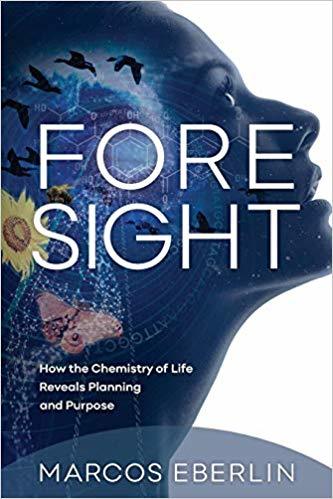
Remember that ID-friendly chemist Marcos Eberlin, whose new book, Foresight: How the Chemistry of Life Reveals Planning and Purpose, features Three Nobel Prize Winners’ Endorsements? We’d mentioned the fact that he and his conference crowd got turfed from Portugal when their ID sympathies were discovered. Here’s a retro on that story:
They had their ID conference. As you can see from the illustration at the top of this post, three separate posters for their event had to be prepared, as it was chased from university to university in Portugal and finally across the border to Spain.
Now we have Dr. Eberlin’s new book, with its endorsements from three Nobel Prize-winning scientists. Ha! The book’s editor, our colleague Jonathan Witt, points out a paragraph from Jonathan Wells’s travelogue piece here about a visit to Brazil, where he was hosted by Marcos. From “Intelligent Design Is Flourishing in Brazil”:
“On the way, Marcos and Neddy serenaded us with the Brazilian song “Maluco Beleza,” or “Cool Crazy Man.” They said this is the official theme song of the Brazilian ID movement, because only “malucos belezas” are sufficiently independent-minded to stand up for ID in the face of materialistic orthodoxy. The song had been made famous by the late Brazilian singing star Raul Seixas, and according to Marcos and Neddy he sang it better than they. “I hope so,” I said, and they laughed.”
Only a “cool crazy man” is “sufficiently independent-minded to stand up for ID in the face of materialistic orthodoxy.” Indeed! Congratulations to Marcos Eberlin, who should wear the designation, maluco beleza, with pride and pleasure. David Klinghoffer, “When Marcos Eberlin Was Chased Out of Portugal” at Evolution News and Science Today.
The book?:
Average Customer Review: 5.0 out of 5 stars 2 customer reviewsAmazon Best Sellers Rank: #8,711 in Books (See Top 100 in Books)#8 in Biochemistry (Books)#33 in Biology & Life Sciences#72 in Evolution (Books)
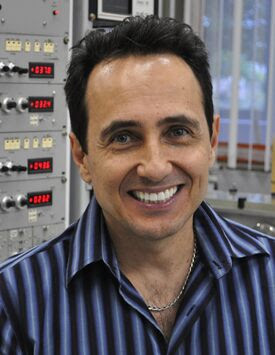
Maybe it should happen to everyone who is intellectually young in a world run by Darwin’s museum pieces. It’s becoming a rite of passage, maybe even an honor.
Follow UD News at Twitter!
See also: ID-Friendly Scientist’s Book Features Three Nobel Prize Winners’ Endorsements
ID Conference Intended For Portugal Had To Flee To Spain “A group of students at the University of the Algarve, in Faro, Portugal, wanted to have a one-day conference on ID at the university. They invited Professor Marcos Eberlin of Campinas State University in Brazil (the 2016 Thomson Medal winner) and me, to speak. The conference was scheduled for Monday, October 23, with university endorsement. (2017)”
Brazilian chemist explains how ID informs his science
and
ID-friendly Brazilian prof wins medal
Brush up on your Portuguese here:
Copyright © 2019 Uncommon Descent . This Feed is for personal non-commercial use only. If you are not reading this material in your news aggregator, the site you are looking at is guilty of copyright infringement UNLESS EXPLICIT PERMISSION OTHERWISE HAS BEEN GIVEN. Please contact legal@uncommondescent.com so we can take legal action immediately.
Plugin by Taragana
Scallops’ 200 eyes “even more complex” than realized
The 200 eyes’ complexity is still being unveiled, we are told:
For many years, the physics and optics of the scallop eye posed a perplexing problem. “The main retina in the eye gets almost completely unfocused light because it’s too close to the mirror,” says Dan Speiser, a vision scientist at the University of South Carolina and the senior author of the new study. In other words, any image on the proximal retina would be blurry and out of focus. “That just seems so unreasonable to me,” Speiser says.
The new study sheds some light on this mystery. The researchers found that the scallop pupils are able to open and contract, though their pupillary responses aren’t as quick as our own. A scallop pupil’s diameter changes by about 50 percent at most, and the dilation or contraction can take several minutes. Their eyes don’t have irises like our eyes do, and instead, the cells in the cornea change shape by going from thin and flat to tall and long. These contractions can change the curvature of the cornea itself, opening the possibility that the scallop eye might change shape and respond to light in a way that makes it possible to form crisper images on the proximal retina.
Viviane Callier, “What Scallops’ Many Eyes Can Teach Us About the Evolution of Vision” at Smithsonian Magazine
Take a deep breath and keep repeating “It all just happens randomly somehow. The same random way buildings get built and books get written.”
Follow UD News at Twitter!
See also: Science Mag: Scallop’s Eye “Fine-Tuned For Image Formation” (2017)
Copyright © 2019 Uncommon Descent . This Feed is for personal non-commercial use only. If you are not reading this material in your news aggregator, the site you are looking at is guilty of copyright infringement UNLESS EXPLICIT PERMISSION OTHERWISE HAS BEEN GIVEN. Please contact legal@uncommondescent.com so we can take legal action immediately.
Plugin by Taragana
Michael J. Behe's Blog
- Michael J. Behe's profile
- 219 followers



